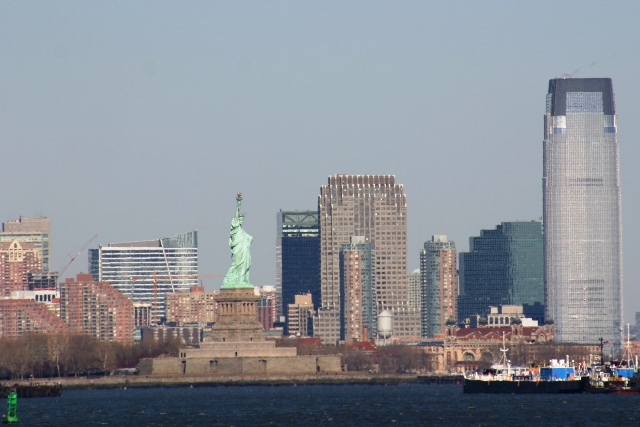It was snowing in North America, and we had heard that US airports were closing all down the Eastern seaboard. Standing in the terminal at Ottawa airport, I watched with interest as a small jet spooled up and began to taxi through deep snow, closely followed by a pair of snowploughs which were in turn being trailed by a private light plane, all on their way to the runway. Clearly, the Canadians weren’t bothered by the conditions.
On our way to the departure gate, I was amused to see that the Canadian bookshops had wheeled out prominent trolleys of US-critical books; the works of Noam Chomsky, various titles incorporating the word “Empire”, and one memorably entitled “100 Ways America is Screwing Up the World”. I don’t know if the stallholders were making a point, or if those titles aren’t readily available in the US, but for whatever reason, they were doing brisk business with passing travellers.
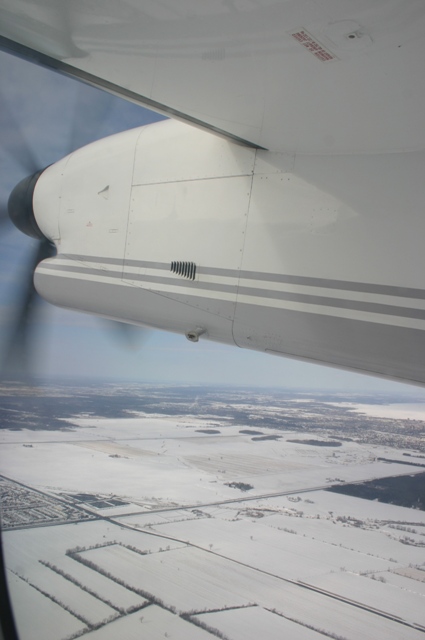
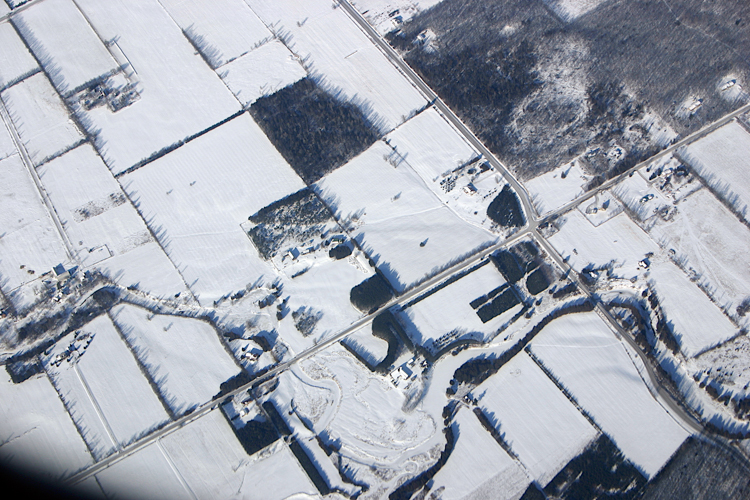
Once in New York, we couldn’t be bothered to worry about taxis and public transport, so we did the obvious thing and hired a limo to take us through to our hotel, which was in Manhattan, just off Times Square. As a first-time visitor, I found the journey strange, like driving through a movie set: The straight canyon-like roads, the big blocky department stores, and the exotically corniced apartment buildings. I kept expecting to see gun-waving movie stars tumbling off the fire escapes.
The standard of driving was awful. Cars criss-crossing all over the place, pedestrians dodging between the hurtling vehicles. Our own driver slalomed around a man tottering through three lanes of traffic on a walking frame and then, having successfully negotiated that hazard, slammed on the brakes as he was cut up by a taxi with JESUS SAVES in the window. “Won’t save him,” chuckled our driver, as he pushed the pedal back to the metal and gave chase. We arrived alive and in good time, checked in to our hotel, and went for a walk to see what all the fuss was about.
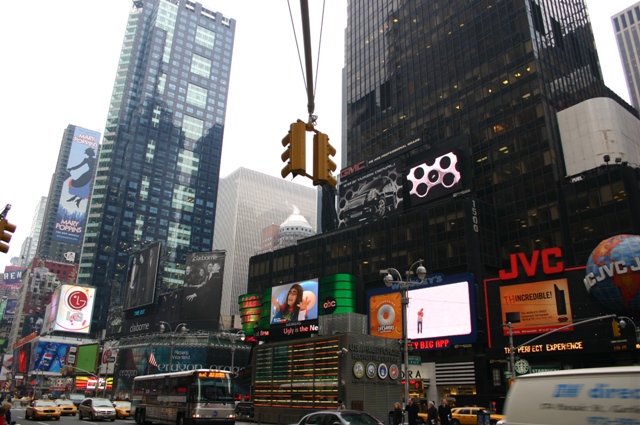
My first impression of Times Square was that it was very tall. My second was that, thanks to the festoons of hi-tech advertisements, it was very bright; certainly brighter than Picadilly Circus in London, and in downright gaudiness it outshone even the Bund in Shanghai. Down at street level, though, I was surprised by how calm everybody was. In London, people would be scurrying along, head down, shouldering aside any fool foreigner with the temerity to hesitate or to pause. Here, groups of people stood around chatting on street corners despite the cold winter wind that cut through the spaces between the buildings. There was plenty of time to take in the views, to stop and to backtrack, even to pause and to take photographs: just so long as you stayed on the pavement (“sidewalk”) and didn’t step into the road (“pavement”). The traffic was still crazy.
In counterpoint to the calm of the civilian New Yorkers, the high-profile security was grim. Quite apart from the officers directing traffic, there were police and police cars stationed at almost every intersection, and immense armoured buses labelled “Command Center” hogged the sidewalks. At one point, a column of (I kid you not) twenty police cars wailed and flashed their way nose-to tail down the centre of the street for no obvious reason. I could only wonder at what possible crisis could have engendered that kind of fire power. Had aliens landed in Central Park? Or had some fool Englishman been spotted jay-walking?
I did notice, though, that although we tourists gawped at the police cars, the locals ignored them completely. Likewise, nobody else seemed to be aware that every shop had its own retinue of uniformed thugs on the door, and in one small shoe shop I counted five security guards. In a shoe shop! I found all this security to be very uncomfortable, and thus had the perfect excuse to loiter on a bench in the street while the girls did their shopping.
Billed as the largest department store in the world, Macy’s attracted Bronwyn and Michelle like moths to a flame. It was indeed very, very big. We made our way to the shoe section, and as I stepped off the escalator, I reeled in shock as shoe racks dwindled to infinity before me. Bronwyn and Michelle dived into the fray, and I sighed and pulled out a magazine and found an armchair. This was going to be a long one.
Some hours later, Michelle approached a Nigerian lady who was on her knees stacking shoe boxes. “May I look at those?” she asked. “No, those are mine!” said the lady, who then proceeded to load some thirty different pairs onto the checkout desk for purchase.
I was surprised at the rudeness of the staff, who seemed much more interested in chatting to each other than actually serving anyone. I overheard one customer ask an assistant about trainers. The worker plucked a boot from a nearby shelf and brandished it. “I do boots. Not snow boots, not trainers, but boots. B, O, O, T, S. Boots!” The customer backed away and, I hope, tried another shop.
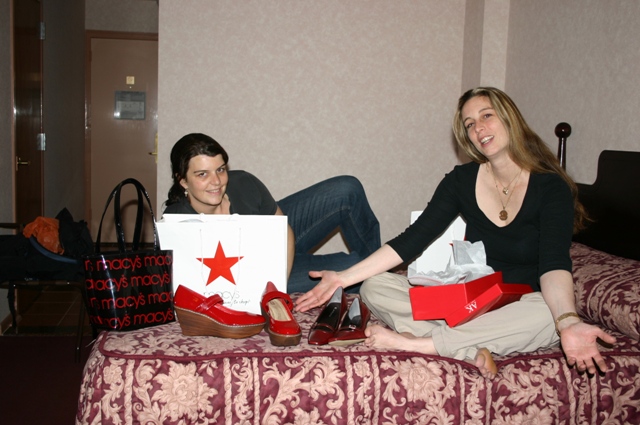
When travelling alone by plane or by bus, anywhere in the world, it often seems to be my lot to end up sat next to a lady of a certain age from New York. Seconds into the journey, she will inevitably attempt to grill me in a very loud voice on all aspects of my private life. Undeterred by my monosyllabic responses, she will then launch into a long and tedious explanation of the shortcomings of her current or previous partners, followed by a detailed explanation of her own medical problems, and topped by an excruciatingly detailed critique of the shortcomings of everything and everybody around her. The dullness of the narrative will only be exceeded by the volume at which the monologue is conducted.
I had hitherto assumed that this was a peculiarity of The New Yorker Abroad, and that in their home territory they would be as urbane as sophisticated as the next person. I was fascinated, then, to find myself seated in the coffee lounge (actually a Starbucks) in Macy’s, completely surrounded by tables packed with exactly the same ladies all jabbering away at full bore. In moments I had inadvertently learned more about the medical, social, and sexual habits of the nearest half-dozen people than I would have believed possible.
Some minor spillage had occurred on the floor behind me. A couple of male janitors turned up to deal with it, and then, instead of moving on, they rested on their mops and began to congratulate each other in stentorian tones on their delight and happiness with having secured employment at the biggest department store in the world. It was time to move on.
It was time, in fact, to experience the Perfect Martini at a bar in Times Square, where Debra our barmaid let on that she was only doing bar work until she got her big chance on Broadway. We wondered how many of the beautiful people that served us in bars and cafes were waiting for the same thing. On Broadway itself, we booked dinner at Sardis, a restaurant which has been awarded a Tony in recognition of its services to the arts. After a fine meal, we ambled next door to see A Chorus Line, a very entertaining show during which the actors kept us on our toes with their seventeen intertwining musical plots.
Later that night, our taxi was stopped by a police line close to the hotel, and had to make a detour. Further around the block we could see a flurry of police cars and lots of shouting people, some of whom were apparently being removed from a club and efficiently bundled into official vehicles. We gathered from the driver’s attitude that this was a normal evening’s work. Later that night, back in the hotel room, I was awoken by more sirens, and more shouting in the street outside. I ignored it and went back to sleep.
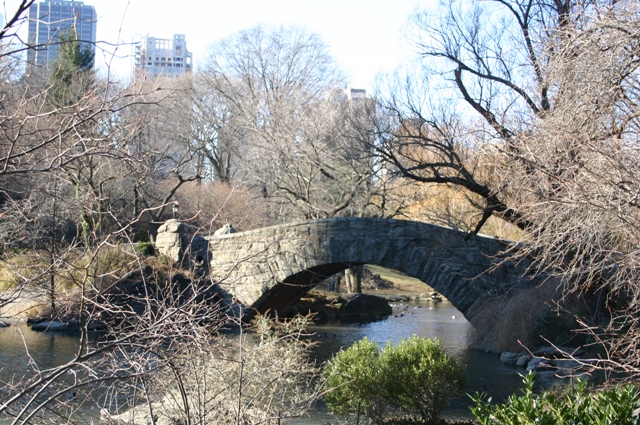
You must remember that, until now, my entire experience of Manhattan had come from Hollywood films. I therefore pictured Central Park as a perpetually darkened forest populated with bloodthirsty aliens, predatory junkies, and roving gangs of youths with baseball bats. I was somewhat surprised, then, to find myself strolling through a pleasant and airy park with quaint little bridges and areas of freshly reseeded lawn.
It was winter, so the trees were bare, and where here and there bedrock projected from the soil, we could climb up and admire the New York skyline all around. A homeless guy came up and sold us a map, and following its directions we made our way past the Trump outdoor icerink, and on to The Tavern On The Green. The Tavern is an amazing confection of ornate windows, pastel-painted plaster, coloured glass and chandeliers, where we breakfasted extravagantly on Veuve Clicquot, lobster bisque, and seared sea-bass. The staff were polite and professional, and there was not a bouncer in sight. Wonderful.
Outside the restaurant, we came across some horse-drawn carriages, so we took a $40 trip around the corner. It was still freezing cold, but they gave us a nice warm blanket to snuggle under.
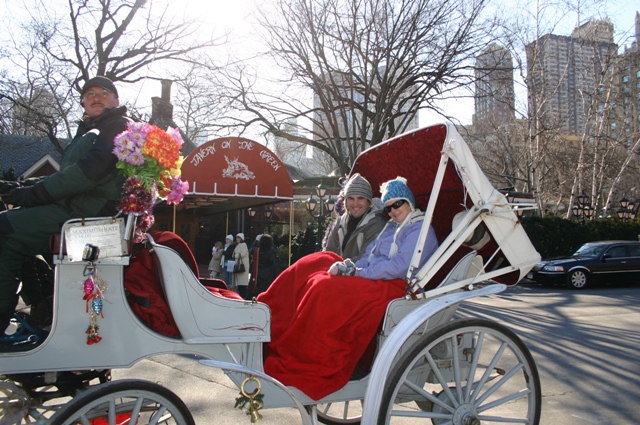
Fifth Avenue, where we disembarked, was spectacular, lots of Gotham-style fifties architecture and a wide street down which the winter sun shone with silvery splendour. Even here, people didn’t seem to mind when I stopped to take photos, and we had a very pleasant stroll up to the Rockefeller Center, where we were hoping to get onto the ice rink.
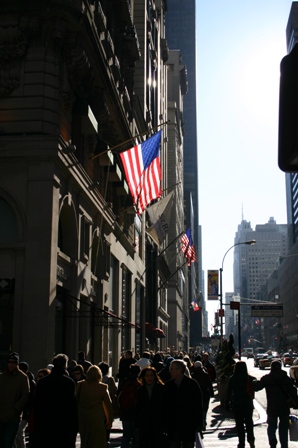
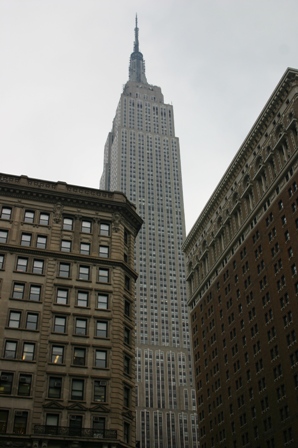
The rink was, however, temporarily closed for resurfacing, so while the Zamboni did its work, we decided to climb up to the roof to take in the view. It wasn’t quite as simple as that; first we had to be X-rayed and examined by yet more security guards, but finally we were allowed to enter the express elevator to the top. The views were fantastic. We were protected from the wind by high glass walls, and could see most of the city stretched out beneath us. Some of the older buildings had the most fascinating wedding-cake architecture. Now dwarfed by the Rockefeller Center, they were once the tallest buildings in Manhattan, and I was impressed by the detail and tile work on their crowns, which can at the time only have been seen by the builders themselves, and perhaps by the pilots of low-flying aircraft.
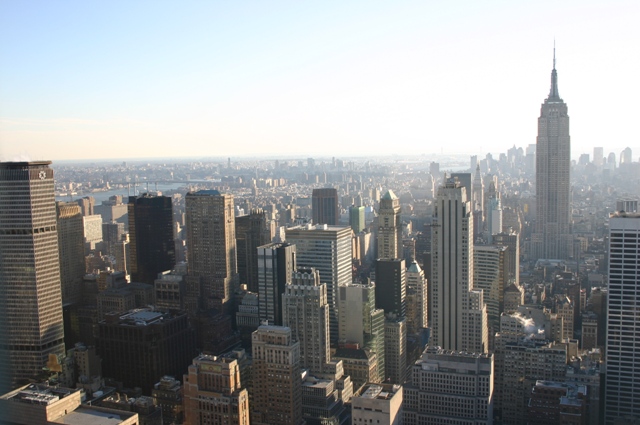
Back at ground level, we did get to skate around the rink amongst the laughing locals and tourists, all slipping and sliding about on the roughly chopped surface. We wouldn’t have won any medals for style, but it was certainly a lot of fun.

The best way to see the Statue of Liberty is to take the free ferry across to Staten Island and back, and the best way to get to the ferry is to take the subway. We therefore found ourselves rattling along in a shiny aluminium train car (no graffiti, no marauding aliens, no gunfights) to emerge in the vast circular waiting room of the ferry terminal. A flustered kiosk girl eventually managed to serve coffee to an ever-lengthening queue of patrons, and then we all filed aboard.
Here, as everywhere else in Manhattan, security guards loomed and checked everything that moved, and on reading the ferry’s safety instructions, I found that there were standing orders that in the case of enemy attack, the crew should rinse the decks with fire hoses to remove any radioactive contamination. Nobody seemed to be attacking at the moment, though, so we concentrated on the scenery, which was very fine indeed on this crisp sunny day.
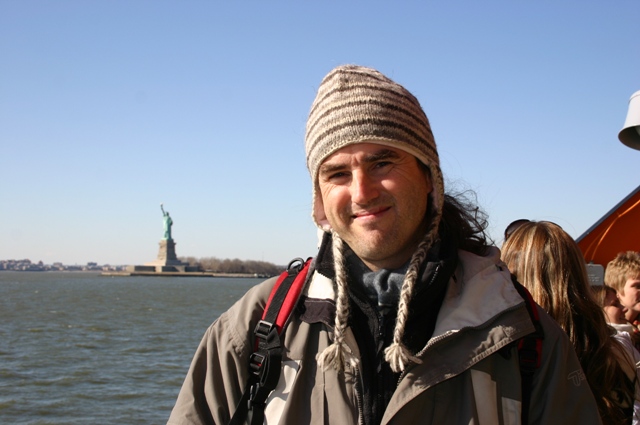
I have heard people say that they are disappointed when they first see the Statue of Liberty, but I really can’t think why. She is very impressive indeed, even more so when you see her standing in front of all the towers and glass of the Manhattan shoreline, like the last bastion of gentility holding her torch in front the glitzy new crowd, and saying “Hey! Remember how things used to be?”
